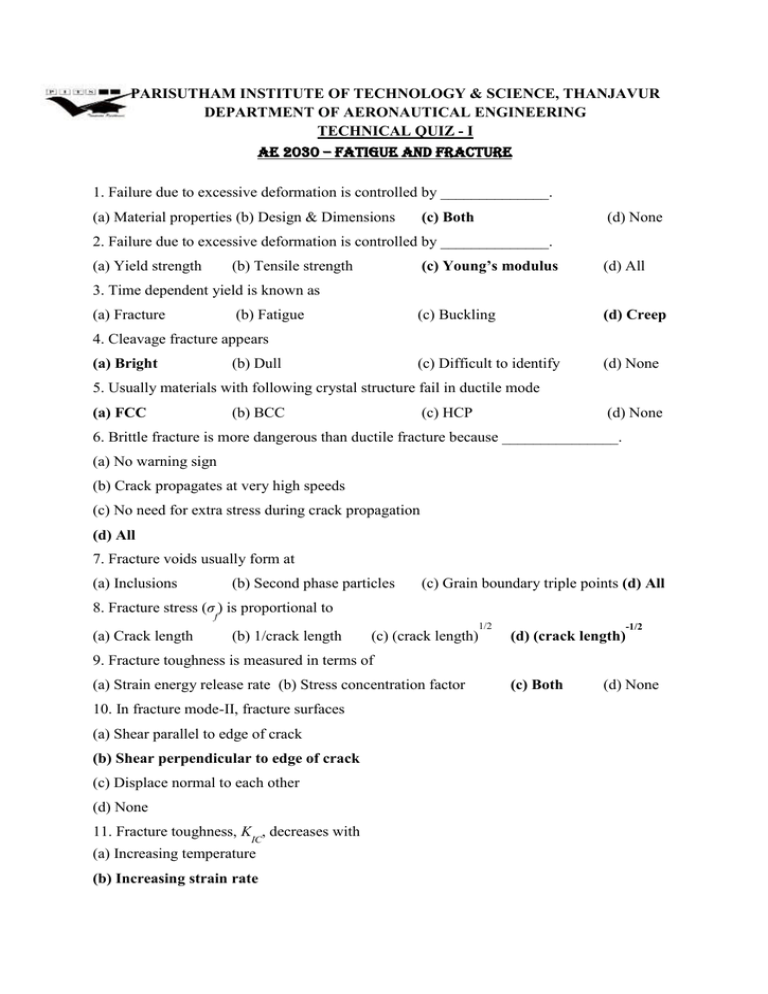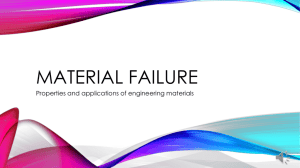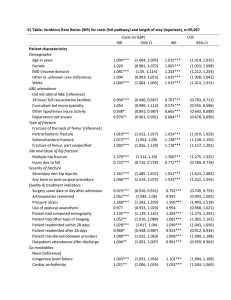F_F TQ -I
advertisement

PARISUTHAM INSTITUTE OF TECHNOLOGY & SCIENCE, THANJAVUR DEPARTMENT OF AERONAUTICAL ENGINEERING TECHNICAL QUIZ - I AE 2030 – FATIGUE AND FRACTURE 1. Failure due to excessive deformation is controlled by ______________. (a) Material properties (b) Design & Dimensions (c) Both (d) None 2. Failure due to excessive deformation is controlled by ______________. (a) Yield strength (c) Young’s modulus (d) All (c) Buckling (d) Creep (c) Difficult to identify (d) None (b) Tensile strength 3. Time dependent yield is known as (a) Fracture (b) Fatigue 4. Cleavage fracture appears (a) Bright (b) Dull 5. Usually materials with following crystal structure fail in ductile mode (a) FCC (b) BCC (c) HCP (d) None 6. Brittle fracture is more dangerous than ductile fracture because _______________. (a) No warning sign (b) Crack propagates at very high speeds (c) No need for extra stress during crack propagation (d) All 7. Fracture voids usually form at (a) Inclusions (b) Second phase particles (c) Grain boundary triple points (d) All 8. Fracture stress (σf) is proportional to (a) Crack length (b) 1/crack length (c) (crack length) 1/2 (d) (crack length) -1/2 9. Fracture toughness is measured in terms of (a) Strain energy release rate (b) Stress concentration factor 10. In fracture mode-II, fracture surfaces (a) Shear parallel to edge of crack (b) Shear perpendicular to edge of crack (c) Displace normal to each other (d) None 11. Fracture toughness, KIC, decreases with (a) Increasing temperature (b) Increasing strain rate (c) Both (d) None (c) Increase in yield strength (d) Increase in grain size 12. DBTT for ceramics is in the range of _________ X Tm. (a) 0.1-0.2 (b) 0.2-0.3 (c) 0.3-0.5 (d) 0.5-0.7 13. Following impurity decreases DBTT for steels (a) Mn (b) P (c) Si (d) Mo 14. Fatigue strength for non-ferrous materials in defined at _______ stress cycles. 3 (a) 10 (b) 10 5 9 7 (c) 10 (d) 10 15. The following equation defines S-N curve (a) Paris equation (b) Basquin equation (c) Andrede equation (d) Garofalo equation 16. Creep rate in ternary stage __________. (a) Decreases (b) Constant (c) Increases (d) None 17. Ternary stage creep is associated with ____________. (a) Strain hardening (b) Recovery (c) Necking (d) None (c) around 50% (d) > >50% 18. Total strain range in a creep test (a) <1% (b) around 10% -2 -4 19. Creep mechanism that is operational at stresses 10 >σ/G >10 _____________. (a) Dislocation creep (b) Dislocation glide (c) Diffusion creep (d) GB sliding 20. Most often machine components fail by (a) Buckling (b) Creep (c) Fatigue (d) All 21. If the surface crack causing fracture in a brittle material is made twice as deep, the fracture strength will (a) Decrease by a factor of √2 (b) Decrease by a factor of 2 (c) Decrease by a factor of 2 2 (d) No change 22. The maximum load that the material can withstand per unit area is called as (a) Brittleness (b) Hardness (c) Ductility (d) Ultimate Tensile Strength 23. The resistance of a material to indentation is resistance to plastic deformation is called as A. Brittleness B. Hardness C. Ductility D. Maleability 24. The progressive deformation of material at constant stress is called A. Strength B. Creep C. Oxidation of Materials 25. The fatigue failure occurs due to after period of D. None of These A. Cyclic Stress B. Cyclic Temperature C. Cyclic Oxidation D. Cyclic Time 26. Which is not in the mechanism of creep? A. Vacancy Diffusion B. Edge Dislocation C. Elastic after Effect D. None of These 27. Which is not creep resistant material? A. Thoria B. Refractories C. Steel Based Alloys D. None of These C. Strain Rate D .Density 28. Which will not affect the creep? A. Stress B. Temperature 29. The critical stress value is known as A. Ideal Stress B. Ideal Fracture Stress C. Shearing Fracture Stress D. Shearing Stress 30. Give the example for slow application of external load A. Tension B. Impact C. Fatigue D. Creep 31. Give the example for rapid application of external load A. Tension B. Impact C. Fatigue D. Creep 32. Give the example for repeated cyclic loading A. Tension B. Impact C. Fatigue D. Creep 33. Give the example for t and T dependent failure under a constant load A. Tension B. Impact C. Fatigue D. Creep 34. Which type of fracture occurs in polycrystal ductile materials? A. Ideal Fracture B. Brittle Fracture C. Ductile Fracture D. Shearing Fracture 35. Which type of fracture occurs in single crystal and polycrystal brittle materials? A. Ideal Fracture B. Brittle Fracture C. Ductile Fracture D. Shearing Fracture 36. Which type of fracture occurs in single crystal ductile materials? A. Ideal Fracture B. Brittle Fracture C. Ductile Fracture D. Shearing Fracture 37. Which type of fracture takes place some stress above the shear strength of the material? A. Ideal Fracture B. Brittle Fracture C. Ductile Fracture D. Shearing Fracture 38. Which type of fracture occurs without any warning? A. Ideal Fracture B. Brittle Fracture C. Ductile Fracture D. Shearing Fracture C. Rupture D. None of These C. Rupture D. None of These C. Rupture D. None of These C. Rupture D. None of These 39. Which type of material has neck formation? A. Brittle B. Ductile 40. Cast iron is the example of which material? A. Brittle B. Ductile 41. Glass is the example of which material? A. Brittle B. Ductile 42. Mild steel is the example of which material? A. Brittle B. Ductile 43. Slow, continuous and time dependent deformation at elevated temperature and stress is called A. Fracture B. Hardness C. Fatigue D. Creep 44. The ability to withstand large deformation without neck formation A. Fracture B. Super Plasticity C. Super Elasticity D. Creep 45. Which material undergoes extended plastic deformation and observer significant energy before fracture? A. Brittle B. Ductile C. Rupture D. None of These





